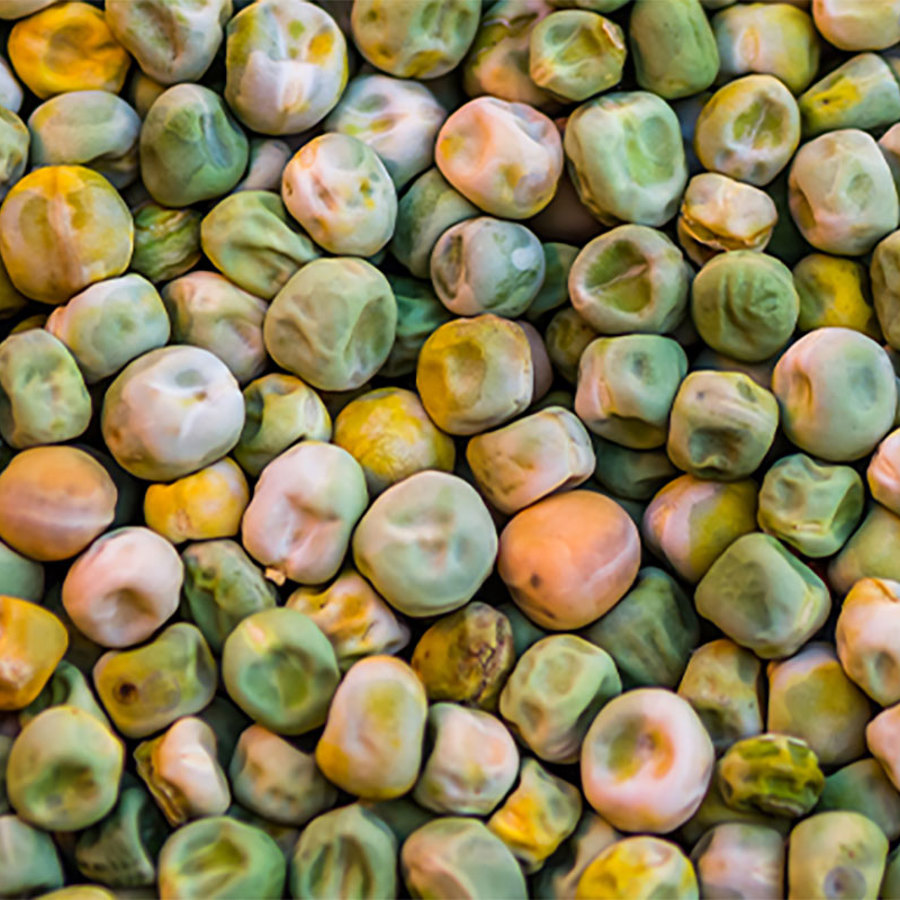
If we cross a heterozygous pea plant, could we get both yellow and green peas on the same plant?
February 11, 2022

- Related Topics:
- Punnett squares,
- Classical genetics,
- Dominant and recessive,
- Plant biology
A high school teacher from India asks:
“If we self cross heterozygous yellow seed pea plant, will we get both yellow and green seeds on that same plant?”
The short answer is no, the heterozygous pea plant in question will only have yellow seeds. However, the offspring that might result from selfing this plant could have green or yellow seeds — but each one will have only one seed color, never a mix.
Let’s dig into why this is!
Slipping into your favorite genes
To get to our answer, we’ll want to cover a few genetics ground rules.
As you may be aware, traits like seed color are determined by the genes in a plant’s DNA.
In the case of Mendel’s peas, there are two different versions, or alleles, for seed color: yellow (Y) and green (y). Every plant will have two copies of each gene. We call this combination of alleles the plant’s genotype.
The seed color we can observe is called the phenotype. Since seed color in pea plants is determined entirely by genetics (in fact, determined entirely by one gene!), you can actually perfectly predict the phenotype from the genotype. This isn’t always the case, but let’s mind our peas and q’s first!
The baby has your seed color
In pea plants, seed color is an example of complete dominance. This means the dominant allele only needs to be present in one copy to give rise to the trait. A recessive allele must be present in two copies. For seed color, the yellow allele (Y) is dominant while the green allele (y) is recessive.
Combining that together, you get:
|
Genotype |
Phenotype |
|
YY |
Yellow |
|
Yy |
Yellow |
|
yy |
Green |
Now we can see that there are three possible genotypes for seed color. Two give us yellow seeds, while one gives us green seeds.
Two genes diverged in a yellow pea plant
So now that we’ve got our feet under us with what dominant and recessive alleles are, let’s move onto thinking about crosses.
The first thing we need to remember is that the egg and sperm will each have only one copy of any given gene.
This is necessary because we want to make sure that plants always have two — and only two — copies of each gene. Otherwise, we’d double the number of alleles every generation! And that would make things get wonky pretty quickly.
So eggs and sperm only have one copy of the seed color gene. But here’s the catch. Their seed color is determined by the DNA of the plant that made those eggs and sperm. For a heterozygote (Yy), that means that all the seeds will be yellow — even though some of them have the yellow allele and some have the green allele.
Prediction Party with Reginald C. Punnett
Like I mentioned at the beginning of the article, seed color is determined entirely by one gene. This means we can predict the seed color of the offspring resulting from crossing a heterozygous yellow-seeded plant to itself.
To illustrate crosses like this, we can use a diagram called a Punnett square.
To set up a Punnett square, you write the possible alleles for the eggs or sperm of each parent, one across the top and the other down the side.
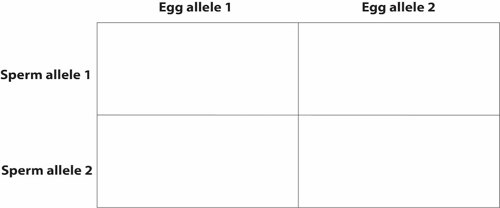

So, for our heterozygous yellow pea plant, the eggs will have either the Y allele or the y allele
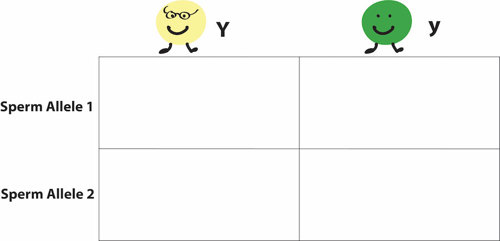

And since we’re selfing this plant, the same goes for the sperm.
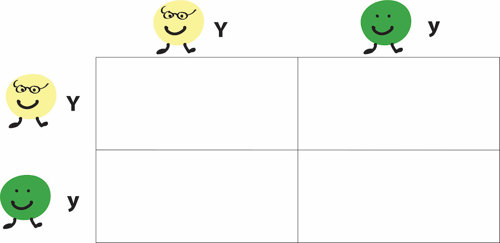

Now we can fill in the combinations that would arise from each pairing of sperm and egg to figure out the possible outcomes of this cross.
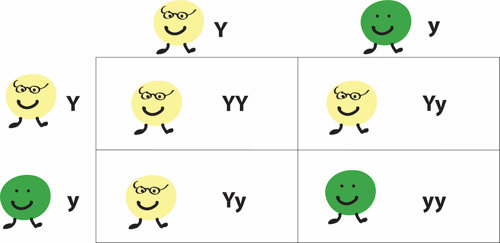
Now we can see from our Punnett square that some of the offspring will end up with yellow seeds and others will end up with green seeds. Exactly which allele ends up in each seed is random.
If we did this experiment enough times in real life, we would see something very close to a 1:2:1 ratio of plants with the YY:Yy:yy genotype. And we would see something very close to 3:1 for yellow to green seeded plants!
Our observed ratios would only be “very close” to our predictions because there’s always slight variability in random events. Think about how you might get 2 tails in a row flipping a coin, even though you’d expect to get one heads, one tails.
And there you have it. A heterozygous yellow pea plant will only ever have yellow seeds, but its offspring could have yellow or green seeds!
“It’s complicated”
I’d like to finish off by mentioning that this logic and Punnett squares don’t work for all traits. Alleles can have complicated relationships with each other, some traits are determined by many genes, and some are influenced by the environment.
Traits that are passed seamlessly from parent to offspring are called Mendelian traits (after Gregor Mendel). In addition to completely dominant relationships (like pea seed color), alleles for Mendelian traits can be incompletely dominant or codominant.
Incomplete dominance means that neither allele is dominant over the other. In these cases, the heterozygote will have an intermediate phenotype compared to the homozygotes.
Four o’clock flowers are an example of this. The offspring of a red and white flowered plant will be pink!
The other Mendelian relationship two alleles for the same gene can have is codominance. For alleles that are codominant, both are independently expressed, meaning that both phenotypes are observed.
This is the case for speckled chickens. Offspring from a black parent and white parent will have a mixture of black and white feathers.
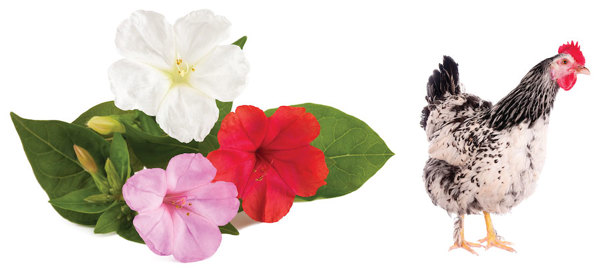
While Mendel discovered many foundational concepts of genetics and inheritance, we know now that many traits are much, much more complicated.
Most traits that we might wonder about on a day to day basis are impossible to apply this logic to. That includes traits like height, aptitude for a particular skill, and personality. Traits like these are influenced by many genes plus the environment, and not inherited in a simple manner from parent to offspring. So unlike our pea plants, you’re completely out of luck trying to predict them based on parental traits.
Read More:
- Scitable: More on how Mendel’s experiments helped us understand inheritance
- The Amoeba Sisters: A primer on non-Mendelian traits
- Lumen Learning: Mendel’s Laws, as told by pea plants

Author: Abby Bergman
When this answer was published in 2022, Abby was a Ph.D. candidate in the Department of Genetics, studying the function of endogenous retroviruses in the development of the placenta in Julie Baker’s laboratory. Abby wrote this answer while participating in the Stanford at The Tech program.
 Skip Navigation
Skip Navigation
